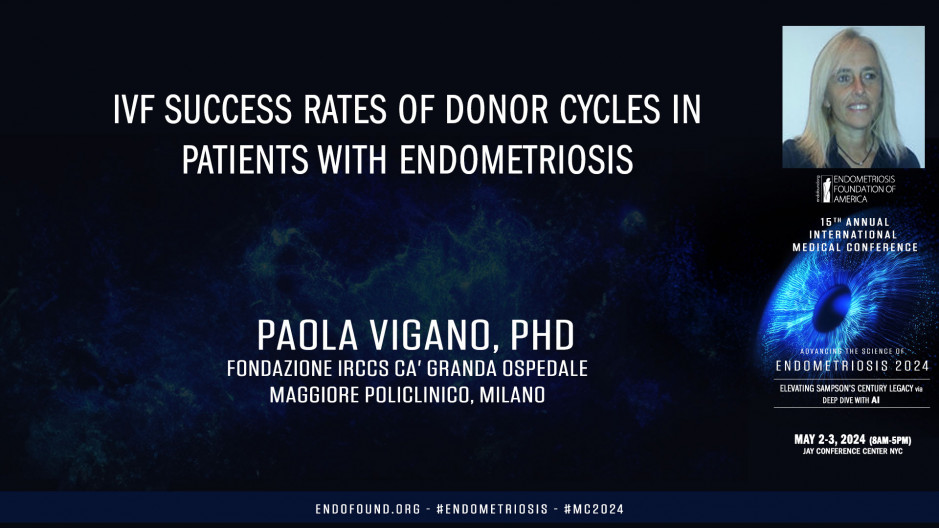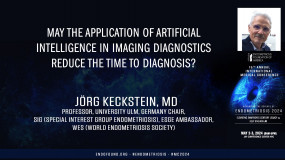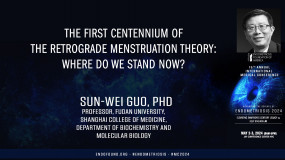International Medical Conference
Endometriosis 2024:
Elevating Sampson’s Century Legacy via
Deep Dive with AI
For the benefit of Endometriosis Foundation of America (EndoFound)
May 2-3, 2024 - JAY CENTER (Paris Room) - NYC
Okay, so this presentation aims to clarify the success rates of Ocid donation IVF cycles in women with endometriosis. But I will also show you that recently the analysis of complex and big data have allowed to obtain very important findings in the field of endometriosis, both from a basic science and clinical point of view. So these are my disclosure. So everybody knows that in Women with End dermatosis, the success rates of autologous IVF cycles have been reported to be lower compared to women with VA causes of infertility. And as a matter of fact, a higher risk of unexpected poor response to a variant stimulation and reduced number of site retrieve have been associated with the disease. So even with endometriosis face a higher risk to be directed toward IDE donation IVF cycles. And our group has recently tried to clarify the issue, which is the success rates of IVF donation cycles with women with endometriosis trying to use the most adequate approach according to the available data.
So we have used two different research strategy. We did a meta analysis of observational available study and we did a retrospective analysis of the UK of the IVF registry. In particular the US after registered and the UK HFE eight registers, all which we will talk later, the meta-analysis of available observation study allow us to include 1000 recipient with Dermatosis and about 7,000 controls only for study could be included in inter analysis, which is quite surprising considering the great number of center worldwide that are doing site donation ideas cycles. The three of the study are quite told toward the study were prospective toward prospective. The study by canal was based on the database of the K-H-F-E-A registry. Endometriosis was laparoscopically proven in free of the study in the study by Canal. No information about the diagnosis of individual two diagnose endometriosis was reported in support of the idea that the study acquired and three of the study the embryos were transferred at the cleavage stage while only the study by al the embryo were transferred involved at cleavage and blast.
Stage two of the study tried to correct for some confirmers and two of the study did not. And this is the results. So the meta-analysis of available observational study showed no significant reduction in live per emal transfer in women with endometriosis in the unadjusted model that you can see in the upper panel. But even after incorporated into the analysis, they adjusted that the difference between the group was not significant, however, the quality evidence was classified as low because there was an high risk of precision bias and the sample size was considered a critical point. So as I told you, we have decided to include also data from registry and particularly we use the US Sarta registry database consulting consulted from 2014 and 2020. It allow us to include 1,600 recipient with endometriosis and 180,000 controls. And this database collected all the characteristic of IVF of IVF treatment per individual year, including all the outcomes, all the characteristics of the cycles.
But many of the data work are aggregated so we could not adjust it for some confounders. Much more interesting is the HFEA database from uk. We are consulted it from 2010 to 2018. It allowed us to include 900 recipient PM with endometriosis and 24,000 control. These database collect characteristic of the I VFS IVF treatment for each of the cycles with all the characteristic of the cycles, including of course the outcome implantation lab rate. And so for this database we did a binomial logistic regression analysis adjusted for patient age, age and double donation that were found to be significantly different between cases and control and data from the two registry were also pulled. There are some advantages and some disadvantages in using the data from registry. Of course the great advantages is that is a real world representation. There is no artificial population is what is the normal clinical practice.
There are no problems of conflict of interest or different regimes of stimulation. You can collect a larger set of data, you have seen the numbers and you can do international comparison of dataset, which we have done. It is low cost and easy to set up compared with randomized control trials. The patient population is not homogeneous. So you can extrapolate the data because it's representative of the real life for sure. It has some disadvantages. You can miss some confounders. It needs for sophisticated statistical analysis to compensate for the impact of ization, which we did. You can have some possible changes in the long term. For instance, the classification of the disease. You can have different local condition in data collection and submission and the long term follow up remains challenging. Anyway, these are the results, the main results of the paper in relation to the registry for live birth rate.
In the upper panel, which corresponded to the unadjusted model, you can see that women with endometriosis are considering only the SAR database. Women with endometriosis showed a significant reduction in lab birth or embo transfer with an absolute difference of minor 3.4%, a difference in 3% in chance of having a live birth in women with endometriosis compared to a recipient without disease. Conversely, considering the HFEA database, the difference between the group who are not significant, both in the unadjusted panel and adjusted model in the upper panel and also in the adjusted model in the lower panel. But as I mentioned before, we also pull the data from the two registry and actually in an adjusted model show a significant reduction in library brain trans women with endometriosis. And if we included the adjusted data from the HFEA database, the findings remains statistically significant. So these are also the results in relation to the different procedure that has been done in women with regard endometriosis.
And you can appreciate that according to the SAR database, the procedure that was mostly significantly affected by the disease work, the frozen embryo transfer always in the context of the IVF donation program. But you can see that the difference here is again, very limited because there is a 51.5% live rate in women with endometriosis versus 55.5% in recipient without the disease. Considering the HFEA database, the procedure that was mostly affected was the use of frozen O site. So the message of this paper and that you can say this message to your patient is that in OSI donation IVF cycles, there is a modest reduction in labor rate between two and 4% among recipient with endometriosis. But you have to remember that the statistical significant for this small reduction were obtained only from the pool analysis of registry. And for sure we cannot exclude that this molar reduction is due to the concomitant presence of adenomyosis in this patient.
But this paper provides another important message beyond the success rates of CY donation program in IVF patient, which is related to the fact that women with endometriosis, there is this idea that there is a uterine impaired uterine receptivity in women effective because actually there is this idea that women with endometriosis as a defective end that can support the endometrial determinants theory or is secondary to the inflammation related to the disease. But you have to remember that at least in IF it is very difficult to assess the uterine receptivity with endometriosis because there are a lot of confounding factors that can limit seriously our ability to assess the youth university because the ovarian reserve, the lower barrier reserve, which is characteristic of women with endometriosis, reduces the rate of optimal embryo to transfer. So it may be the embryo and not the endometrial. Poor responders like women with endometriosis are entire risk for early progesterone elevation that displace the window of implantation. And finally, endometriosis associated with condition that preserve can interfere with implantation included adenomyosis, polyps and end. So the OSI donation model eliminated at least the first two of these factors is a good model to assess the uterine receptivity of these women.
And so based on what I've said so far, there is only a two 3% reduction in library rate in site donation I bs cycle in women with endometriosis. One may think actually that the atopic endometrial of these women is not so particular dysfunction, at least for the fertility issue. And the fertility issue of this patient is probably not related to the impaired uterine re receptivity. And there are a lot of clinical experts that support these view, mostly of them in the IVF field. But if you talk with basic scientists, they completely disagree with this vision because basic who has evaluated at the molecular level, the endometrial of women with end, they found so many molecular alteration that they suggest dramatic effect on the visualization and implantation and migration. These are only some of the molecules that have been found to be dysregulated in the eutopic endometrial of patients with endometriosis.
Some of these, some of them are upregulated and some are downregulated. And these molecules are not only important for proliferation, but they are mostly important for visualization and implantation angiogenes and so on. So how can we match the results of the uterine re receptivity from basic science, so many molecular alteration detected with those from donor IVF clinical study? Frankly, I don't know. Someone may suggest that there may be a role for ovarian suppression because when you do no side donation IV cycle, you usually do an ovarian suppression. But for sure when basic scientists do not have an ovarian suppression during their experiment.
But what I would like to underline today, it is very directed to the basic scientists because now we know very clear that the molecular profile of the endometrial depends on several variables. And these graphs represent only some of them. For instance, age has been recently demonstrated to be at an impact on the transcriptomic profile of endometrial. But for sure the most important variable is the face of the menstrual cycle. And I want to conclude with this fantastic paper that has been recently published in nature communication some months ago, published by the group of Graham Montgomery and Peter Rogers, in which the authors address some methodological challenges in the endometrial research and in particular the large variation in mest cycle length and the huge variability in gene expression across the cycle. At some point of the paper, the author declare that the changing in gene expression in menstrual cycles with different cycle length make the accurate comparison among samples difficult at best, if not completely impossible. So on this basis, they try to develop and validate a new method to a correctly determined menstrual cycle stage based on changing endometrial gene expression. And what they found is that there are about 3000 genes that change expression significantly within a 3.4% period of the endometrial cycles, which approximately correspond to a 24 hours period. In a 20 day cycles of this, about 3000 were during the secretary phase. And I show you what of the sample, this is phospholipase two in which you can see actually that the, oops,
Sorry,
In which you can see that the expression is stable during the proliferative phase. But then at the beginning of the secretary phase there is a very rapid peak in the expression, but then the expression goes down and remains quite stable. That goes down during all the secretary phase. And this means that when you apply anomic procedure to your endometrium, the classical definition among proliferative and secretary phase is no longer sufficient to demonstrate that you are collecting a comparable group of samples.
So in conclusion, data from the meta-analysis of observational studies show no reduction in lab rate and donation IV FS cycles C recipient with dermatome. But data from IVF registry show modest reduction in library rate of two 4% in outside donation of cycles among recipient with endometriosis. But we cannot also exclude a role of concomitant adenomyosis. The significant fund could be obtained only thanks to the largest sample size from registry data. For basic scientists, it is time to reinterpret to the basic science experiments on the ome molecular profile with a very particular focus on the face of the menstrual cycle. Because as suggested by all the speaker in this Congress, we need to model the complexity and not try to avoid it. Thank you for your attention.
Let me ask all the speakers to, let me ask all the speakers.










